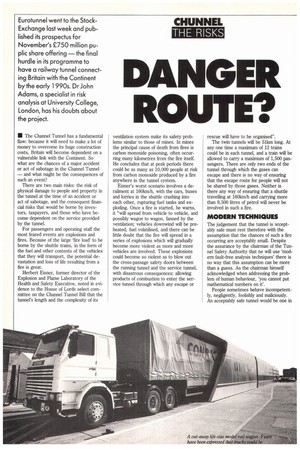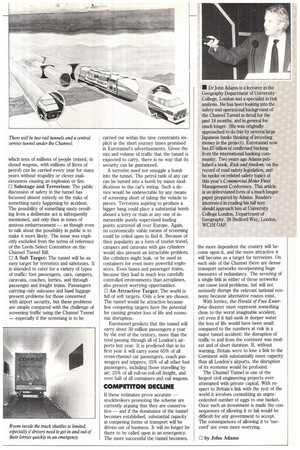DANGER ROUTE?
Page 38

Page 39

If you've noticed an error in this article please click here to report it so we can fix it.
Eurotunnel went to the StockExchange last week and published its prospectus for November's £750 million puplic share offering — the final hurdle in its programme to have a railway tunnel connecting Britain with the Continent by the early 1990s. DrJohn Adams, a specialist in risk analysis at University College, London, has his doubts about the project.
• The Channel Tunnel has a fundamental flaw: because it will need to make a lot of money to overcome its huge construction costs, Britain will become dependent on a vulnerable link with the Continent. So what are the chances of a major accident or act of sabotage in the Channel Tunnel — and what might be the consequences of such an event?
There are two main risks: the risk of physical damage to people and property in the tunnel at the time of an accident or act of sabotage, and the consequent financial risks that would be borne by investors, taxpayers, and those who have become dependent on the service provided by the tunnel.
For passengers and operating staff the most feared events are explosions and fires. Because of the large 'fire load' to be borne by the shuttle trains, in the form of the fuel and other contents of the vehicles that they will transport, the potential devastation and loss of life resulting from a fire is great.
Herbert Eisner, former director of the Explosion and Flame Laboratory of the Health and Safety Executive, noted in evidence to the House of Lords select committee on the Channel Tunnel Bill that the tunnel's length and the complexity of its ventilation system make its safety problems similar to those of mines. In mines the principal cause of death from fires is carbon monoxide poisoning, often occurring many kilometres from the fire itself. He concludes that at peak periods there could be as many as 10,000 people at risk from carbon monoxide produced by a fire anywhere in the tunnel system.
Eisner's worst scenario involves a derailment at 160km/h, with the cars, buses and lorries in the shuttle crashing into each other, rupturing fuel tanks and exploding. Once a fire is started, he warns, it "will spread from vehicle to vehicle, and possibly wagon to wagon, fanned by the ventilation; vehicles downwind will be preheated, fuel volatilised, and there can be little doubt that the fire will spread in a series of explosions which will gradually become more violent as more and more vehicles are involved. These explosions could become so violent as to blow out the cross-passage safety doors between the running tunnel and the service tunnel, with disastrous consequences: allowing products of combustion to enter the service tunnel through which any escape or rescue will have to be organised".
The twin tunnels will be 51krn long. At any one time a maximum of 12 trains could be in each tunnel, and a train will be allowed to carry a maximum of 1,500 passengers. There are only two ends of the tunnel through which the gases can escape and there is no way of ensuring that the escape route for people will not be shared by those gases. Neither is there any way of ensuring that a shuttle travelling at 160km/h and carrying more than 9,500 litres of petrol will never be involved in such a fire.
MODERN TECHNIQUES
The judgement that the tunnel is acceptably safe must rest therefore with the assumption that the chances of such a fire occurring are acceptably small. Despite the assurance by the chairman of the Tunnel Safety Authority that he will use 'modern fault-free analysis techniques' there is no way that this assumption can be more than a guess. As the chairman himself acknowledged when addressing the problem of human behaviour, you cannot put mathematical numbers on it'.
People sometimes behave incompetently, negligently, foolishly and maliciously. An acceptably safe tunnel would be one in
which tens of millions of people (mixed, in closed wagons, with millions of litres of petrol) can be carried every year for many years without stupidity or clever maliciousness causing an explosion or fire. 0 Sabotage and Terrorism: The public discussion of safety in the tunnel has focussed almost entirely on the risks of something nasty happening by accident. The possibility of something nasty resulting from a deliberate act is infrequently mentioned, and only then in tones of anxious embarrassment — as though even to talk about the possibility in public is to make it more likely. The issue was explicitly excluded from the terms of reference of the Lords Select Committee on the Channel Tunnel Bill.
A Soft Target: The tunnel will be an easy target for terrorists and saboteurs. It is intended to cater for a variety of types of traffic: foot passengers, cars, campers, caravans, coaches, lorries, and through passenger and freight trains. Passengers carrying only suitcases and hand luggage present problems for those concerned with airport security, but these problems are simple compared with the challenge of screening traffic using the Channel Tunnel — especially if the screening is to be
carried out within the time constraints implicit in the short journey times promised in Eurotunnel's advertisements. Given the mix and volume of traffic that the tunnel is expected to carry, there is no way that its security can be guaranteed.
A terrorist need not smuggle a bomb into the tunnel. The petrol tank of any car can be turned into a bomb by minor modifications to the car's wiring. Such a device would be undetectable by any means of screening short of taking the vehicle to pieces. Terrorists aspiring to produce a bigger bang could place a substantial bomb aboard a lorry or train at any one of innumerable poorly supervised loading points scattered all over Europe. Again, no economically viable means of screening could be relied upon to find it. Because of their popularity as a form of tourist travel, campers and caravans with gas cylinders would also present an intractable problem; the cylinders might leak, or be used as containers for even more powerful explosives. Even buses and passenger trains, because they load in much less carefully controlled environments than aeroplanes, also present worrying opportunities. 0 An Attractive Target: The world is full of soft targets. Only a few are chosen. The tunnel would be attractive because few competing targets have the potential for causing greater loss of life and economic disruption.
Eurotunnel predicts that the tunnel will carry about 50 million passengers a year by the end of the century, more than the total passing through all of London's airports last year. It is predicted that in its first year it will carry some 65% of all cross-channel car passengers, coach passengers and trippers; 35% of all other foot passengers, including those travelling by air; 25% of all roll-on-roll-off freight, and over half of all containers and rail wagons.
COMPITITON DECUNE
if these estimates prove accurate — stockbrokers promoting the scheme are currently arguing that they are conservative — and if the dominance of the tunnel becomes established, substantial capacity in competing forms of transport will be driven out of business. It will no longer be there to be called upon in an emergency. The more successful the tunnel becomes,
the more dependent the country will become upon it, and the more attractive it will become as a target for terrorists. On each side of the Channel there are dense transport networks incorporating huge measures of redundancy. The severing of a single link in either of these networks can cause local problems, but will not seriously disrupt the relevant national economy because alternative routes exist.
With ferries, the Herald of Free Enterprise disaster must represent something close to the worst imaginable accident, yet even if it had sunk in deeper water the loss of life would have been small compared to the numbers at risk in a major tunnel accident; the disruption of traffic to and from the continent was modest and of short duration. If, without warning, Britain were to lose a link to the Continent with substantially more capacity than all London's airports, the disruption of its economy would be profound.
The Channel Tunnel is one of the largest civil engineering projects ever attempted with private capital. With respect to Britain's link with the rest of the world it involves committing an unprecedented number of eggs to one basket. Once such an investment is made the consequences of allowing it to fail would be difficult for any government to accept. The consequences of allowing it to 'succeed' are even more worrying.
0 by John Adams
























































































































